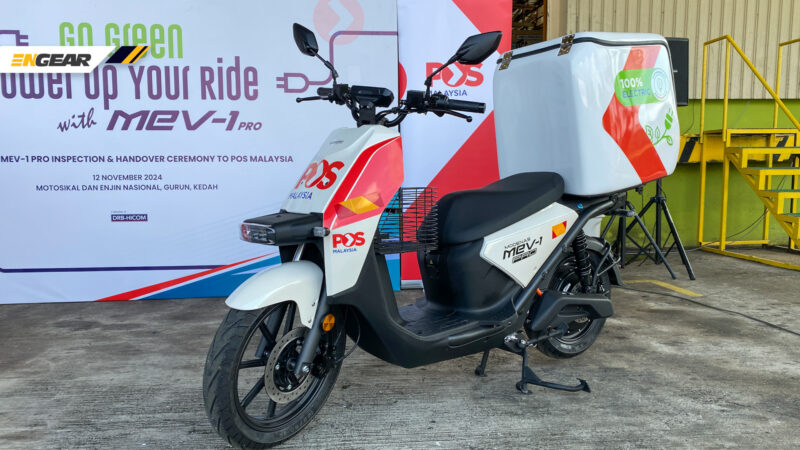Recently, we were invited to the MODENAS factory located in Gurun, Kedah, to attend the handover event of the MEV-1 Pro electric scooter to Pos Malaysia.
This marks the second delivery by MODENAS, with a total of 1,092 units, following the first batch delivered approximately a year ago.
Here are some more interesting facts you should know about the MODENAS MEV-1:
1. Meaning of MEV-1
- Modenas
- Electric Vehicle
- Number 1
For future models, MODENAS plans to use names such as MEV-2, MEV-3, and so on.
2. Collaboration with VMoto
It’s worth noting that the MODENAS MEV-1 is a ‘twin’ of the VMoto VS1 electric scooter model.
MODENAS partnered with VMoto to develop the MEV-1, benefiting from accelerated technology acquisition.
The VMoto brand was chosen due to its durability, efficiency, and superior quality compared to several competitor models that were previously evaluated.
MODENAS CEO, Roslan Roskan, emphasized that choosing a higher-quality model is essential so that Malaysians considering purchasing an electric scooter next year will be more satisfied with the value for money spent.
For your information, VMoto is the official supplier of electric scooters to the Ducati MotoGP team—an impressive brand indeed!
3. Upgrades Took a Year, 10,000 km Endurance Test
Compared to the MEV-1 that has been in use for a year, the MEV-1 Pro is an enhanced version, developed with data on usage and specific needs from Pos Malaysia.
According to MODENAS, among the improvements made include the addition of a manual parking brake button, a sturdier rack support, and the use of a more powerful electric motor.
As a result, the MEV-1 Pro can now generate a power output of 5.8 hp, support loads of up to 250 kg, and tackle steep inclines of 19 degrees.
It is also more heat-resistant, thanks to modifications made to the vehicle control unit and battery system, making it suitable for the more extreme tasks of Pos Malaysia.
4. Worried About Range?
Many electric scooters face a common issue compared to regular mopeds: insufficient riding range for daily operations.
However, this is not a significant problem for our postal workers.
According to Pos Malaysia, an MEV-1 electric scooter travels an average of 40 km each day for deliveries.
This means the standard range offered by the MEV-1 is more than adequate to cover the daily operations of Pos Malaysia.
Nevertheless, in the future, Pos Malaysia is open to the possibility of considering more practical battery swap stations to accommodate growing needs.
5. Interested? Wait Until Next Year
Currently, the MEV-1 and MEV-1 Pro are designated solely for use within the company’s electric fleet, such as Pos Malaysia.
However, MODENAS has promised that an electric scooter available for public purchase will be offered by the first quarter of 2025 (Q1 2025), featuring user-friendly specifications.
Initially, it will be sold as a Completely Built Unit (CBU) with an estimated price in the tens of thousands of ringgit, or possibly below RM10,000 for the locally assembled version (CKD).
Specifications of the MODENAS MEV-1 Pro
Power: 5.8 hp
Torque: 165 Nm
Battery Pack: 5.4 kWh
Range: 95 km
Dimensions: 2,094 x 727 x 1,141 mm
Wheelbase: 1,366 mm
Ground Clearance: 154 mm
Seat Height: 760 mm
Suspension: telescopic front fork, single shock absorber
Tire Size: 100/80-16 front, 110/80-14 rear
Brakes: 240 mm front rotor, 180 mm rear
MODENAS MEV-1 Pro
MODENAS MEV-1 Pro SX
